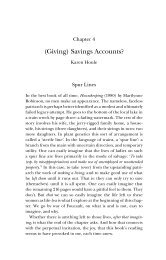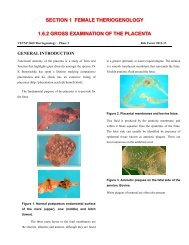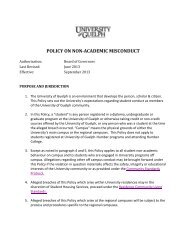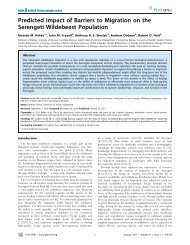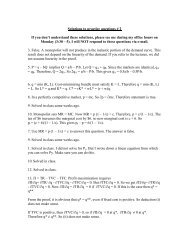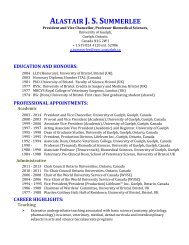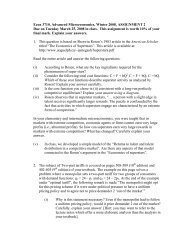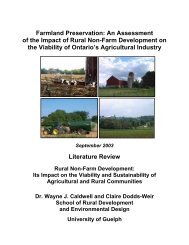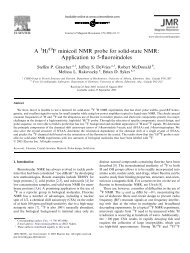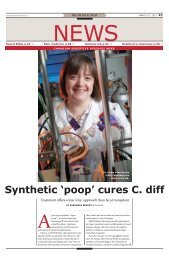econ 3710: advanced microeconomics final exam - University of ...
econ 3710: advanced microeconomics final exam - University of ...
econ 3710: advanced microeconomics final exam - University of ...
Create successful ePaper yourself
Turn your PDF publications into a flip-book with our unique Google optimized e-Paper software.
ECON <strong>3710</strong>: ADVANCED MICROECONOMICS FINAL EXAMDepartment <strong>of</strong> Economics<strong>University</strong> <strong>of</strong> GuelphApril 22, 2006Answer ALL questions. Show how you got your answers. You have 120 minutes. Eachquestion is worth 20 marks. Questions 1 and 2 have two types <strong>of</strong> questions. Part 1-typequestions are worth 10 marks (50%) and part 2-type are also worth 10 marks (50%).Part 2-type questions are harder than part 1-type questions. Part 1-type are questionsthat the average student, who has worked hard, can easily answer and guaranteehim/herself a decent mark in this course. Questions 3 and 4 have only part 1-typequestions. Since only two questions have part 2-type questions, it follows that part 2-type questions have a weight <strong>of</strong> 0.5(50) = 25% <strong>of</strong> the total mark.-Instructor: J. Atsu Amegashie1. A firm has the production function q = K 0.25 L 0.25 , where K is capital, L is labor, and q isoutput. The price <strong>of</strong> capital is v = 4 and the price <strong>of</strong> labor is w = 4. [You may need thisresult: if Y α = Z. Then Y = Z 1/α ].Part 1:(i) Derive the firm’s short-run cost function if capital is fixed at K = 16.(ii) Derive the firm’s long-run cost function.Part 2:(iii)Someone claims that the firm’s short-run cost function rises slower than its long-runcost function. Is this person right? Prove your answer mathematically and explain itintuitively.2. Part 1: [Straight from the lecture notes with/without a slight change]:(i) An individual has the vNM utility function u(w) = w , w is her wealth. Her currentwealth is $10,000 but there is a 50% probability that she will lose $6400. What is themaximum she will pay to fully insure against the loss <strong>of</strong> $6400. Show how you got youanswer.(ii)Show that if a person is risk-neutral, then her expected utility is the same as herexpected income.Part 2:(iii) Jane is risk neutral and is asked to participate in the following lottery (raffle). She is theonly person in this raffle. G > 0 units <strong>of</strong> raffle tickets will be put in a box. If Jane buys Xraffle tickets, her name will be written on each ticket and put in the same box. Therefore,there will be G + X raffle tickets in the box. One <strong>of</strong> these tickets will be drawn randomlyfrom the box. If it is Jane’s ticket, her prize will be V dollars. Also, if her ticket is drawn thecost <strong>of</strong> all her raffle tickets will be fully re-imbursed to her. Assume that the price <strong>of</strong> a ticketis $1 and V > G. If Jane’s entire income is $100,000, how many raffle tickets will Jane buy?Would you get the same answer, if Jane is risk-averse? Carefully demonstrate your answer.
3. [Question 2 <strong>of</strong> assignment 2 (Fall 2004) with different numbers. Available withsolutions at the course website]. This question has no Part 2-type questionSuppose a firm faces two markets for the same product. In market A, the demand function isP A = 100 – Q A while in market B, the demand function is P B = 36 – Q B . The marginal cost <strong>of</strong>production is $4.(i)(ii)(iii)If the firm can sell at different prices in the two markets, find the pr<strong>of</strong>it-maximizingprice and quantity in each market. Show how you got your answer.If the firm cannot price discriminate, what price will it charge? Show how you gotyour answer.Compare the pr<strong>of</strong>its in (i) and (ii).4. No part 2-type question: [straight from the lecture notes]: Consider a market with N ≥2 identical firms who face the market demand p = a – Q, where a > 0, p is price, and Q ismarket quantity. The quantity sold by the i-th firm is q i , where i = 1, 2, …, N. Each firmcan produce at a constant average (and marginal) cost <strong>of</strong> c < a. Suppose, using theCournot model, that each <strong>of</strong> these firms chooses its level <strong>of</strong> output to maximize pr<strong>of</strong>itson the assumption that the others levels <strong>of</strong> output are fixed(i)Show that as N approaches infinity (i.e., gets very large), the equilibrium aggregatequantity sold on the market approaches the perfectly-competitive quantity.Christine has the following utility function: U = 100x – x 2 /2 + y, where y is acomposite commodity with price p y = 1 (expenditure on all goods other than good x),and x is rounds <strong>of</strong> golf at the local private golf club. Only members can play at thisgolf club, and one must pay a membership fee to join the club. In addition, for eachround <strong>of</strong> golf played a member must pay $60. That is, the price <strong>of</strong> a round <strong>of</strong> golf is$60. Christine has an income <strong>of</strong> $40,000. [Note: Christine cannot play golf anywhere,except at this private club].(ii)(iii)What is the largest fee that Christine would pay to belong to this club?Suppose she is already a member <strong>of</strong> the club. What is the least amount she willaccept to give up her membership. You do not need any algebra (mathematics) toanswer to this question. However, you should explain how you got your answer.Good luck. Relax. Do not Panic. You can do it.



